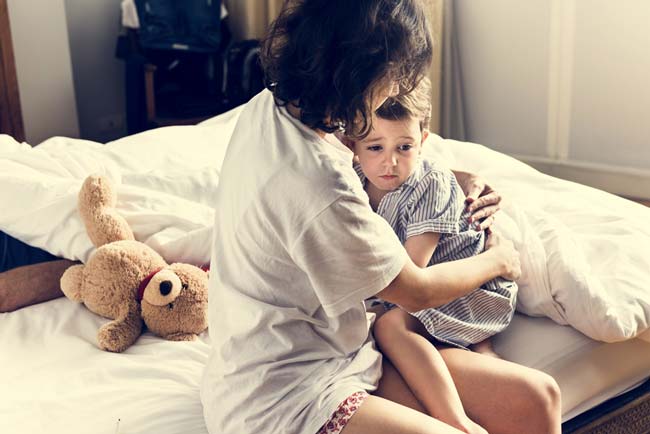You’ve comforted your child after plenty of nightmares. But this time, even though he’s acting like he had a nightmare, he doesn’t seem to actually be awake. What’s happening?
It could be a night terror, a type of sleep disruption that often is similar to a nightmare in appearance, but is very different in reality.
So, what exactly are night terrors? And how can they affect your little one?
David Suhrbier, DO, Chief of Pediatric Neurology at Erlanger Health, who’s board-certified in neurology and sleep medicine, offers some insight.
Q: What are night terrors?
A: Night terrors are a very common sleep problem in children. They’re an abnormal arousal from the deeper stages of sleep.
Very often, what happens is, in the first one-third of the night, you’re in the non-REM stage of sleep. You’re in a deep stage of sleep, and your sleep is suddenly disturbed.
This causes the child to appear to be awake — but unresponsive to family and distressed or agitated. Kids who are experiencing night terrors may scream or resist attempts to be hugged or touched.
They may sit up in the bed or stare at someone, or even kick and lash out at parents.
Night terrors can last anywhere up to 30 minutes, and then the child will return to sleep and have no memory of the event the next day.
Q: Who has night terrors?
Night terrors are fairly common — affecting almost 40 percent of children and even some adults.
These typically happen between ages 2 and 4, and they’ll tend to get better with time with at least 80 percent of these events resolving by age 4.
So, the kids who are experiencing night terrors are usually preschool- and elementary school-aged.
Q: What should parents know about night terrors?
A: Night terrors can be extremely frightening to families. The misperception is that they think kids are awake.
But they’re not. They’re still in the first stage of sleep, which we call drowsiness. That’s why they’re not responsive and may push away from parents.
The important thing that we try to tell families is that 1) the child is not in danger or in pain and 2) the best thing is to try to keep the child from hurting themselves. Don’t try to restrain him or her, just keep trying to guide the child back to sleep.
With night terrors in general, we talk about reassurance and education. You want to make sure there are gates in the doorways and at the stairs, and that you lock outside doors and windows for the protection of the child.
Q: When should parents seek help for night terrors?
A: Right away — the problem is that parents don’t seek help early enough. They only seek help when it’s been going on a long time. By that time, their sleep is disrupted and everything’s out of sync. It’s at the point where parents are literally on their last nerve and looking for a quick fix.
The most important thing that people have to know about sleep problems in kids is that they don’t just disrupt the kids’ sleep. They’re intricately tied together. If you have more than one child, it can impact the other child, too.
I encourage parents to speak with their pediatricians as soon as possible about what their kids are experiencing. The sooner we can intervene, the better off the child is going to be.
They will eventually “outgrow” this sleep problem, but it will grow into another sleep problem.
Q: What can be done for night terrors?
A: In most cases, it’s important to simply console the child and help him or her fall back asleep. But if your child is regularly experiencing night terrors, there’s a technique you can try.
The technique is called “scheduled awakening.” Most children with sleep terrors will have them about the same time each night.
What we then say to parents is—if it’s happening at 11, I need you to go into the room at 10:30 and gently wake the child. Then allow the child to fall back sleep. That oftentimes, in a sense, will reset the sleep clock in their brains.
Believe your child could be experiencing night terrors? Talk with your child’s pediatrician or learn more about Pediatric Neurology here.







